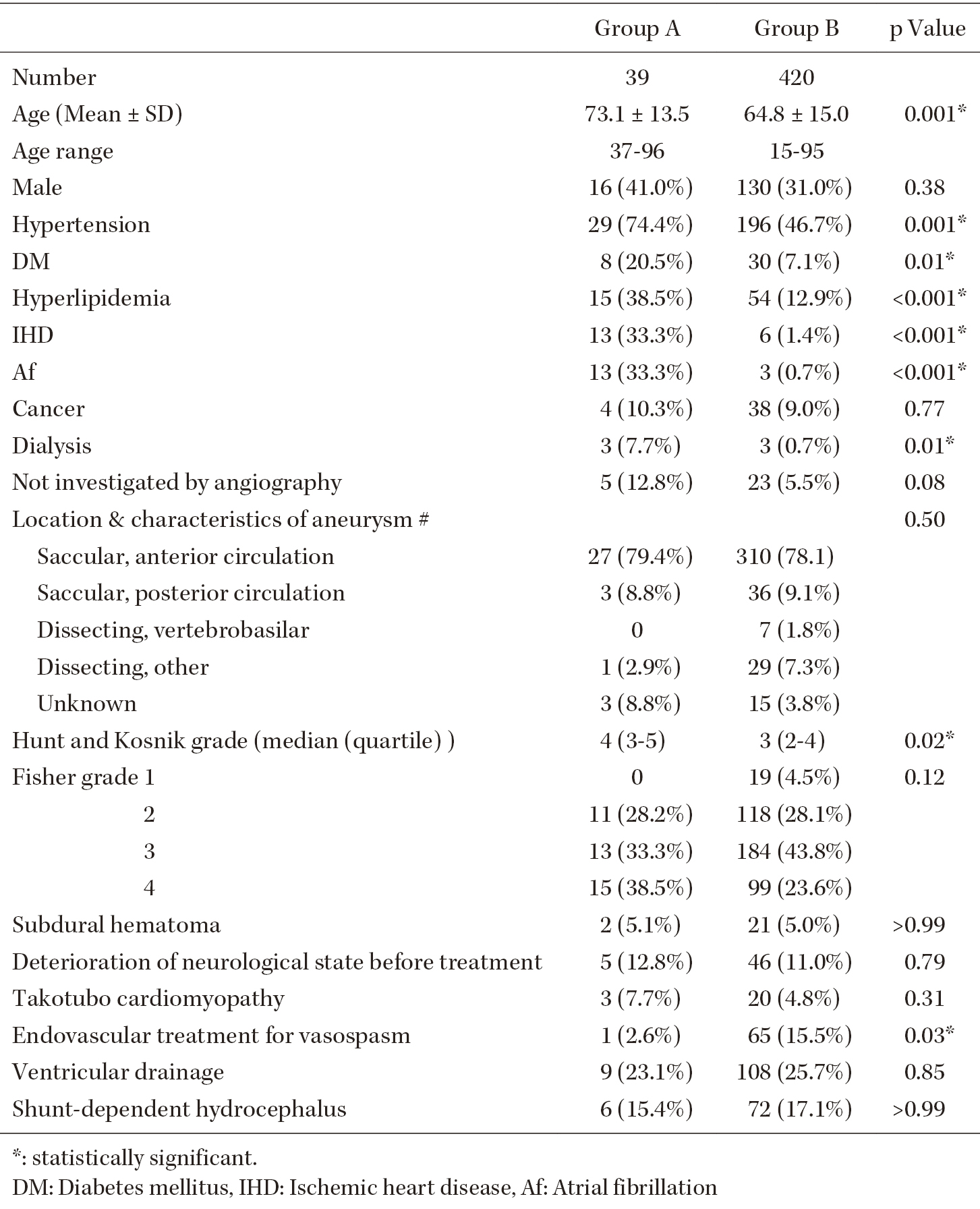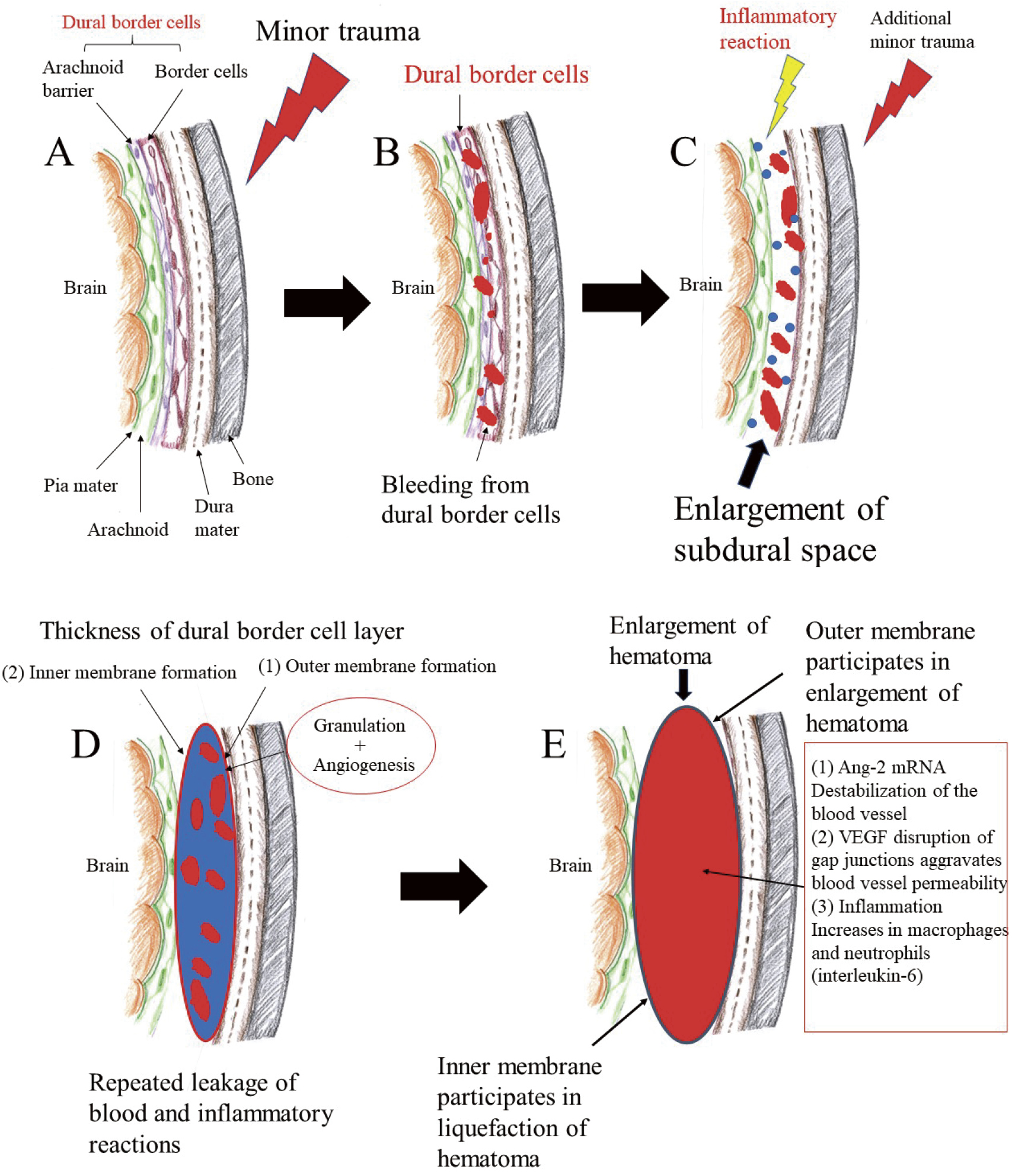- 著者
- Masaaki UNO Kenji YAGI Hiroyuki TAKAI Satoshi HIRAI Yukari MINAMI-OGAWA Yoshifumi TAO Yoshihiro SUNADA Shunji MATSUBARA
- 出版者
- The Japan Neurosurgical Society
- 雑誌
- Neurologia medico-chirurgica (ISSN:04708105)
- 巻号頁・発行日
- pp.2022-0122, (Released:2022-10-13)
- 参考文献数
- 19
With the aging of the population, the number of people taking antithrombotic drugs is increasing. Few reports have described the clinical presentation, treatment, and outcomes of nontraumatic subarachnoid hemorrhage (SAH) in patients with preceding antithrombotic therapy. This study included 459 patients with nontraumatic SAH who had been treated between April 2009 and May 2021. Overall, 39 of the 459 patients with aneurysmal SAH were on antithrombotic therapy before ictus (8.5%). Therefore, we classified patients into two groups: Group A (n = 39), patients with preceding antithrombotic therapy and Group B (n = 420), patients without preceding antithrombotic therapy. Hunt and Kosnik (H&K) grade on admission was significantly higher in Group A than in Group B (p = 0.02). Patients in Group A more frequently received endovascular treatment. The rate of endovascular therapy for symptomatic vasospasm after SAH was significantly lower in Group A (2.6%) than in Group B (15.5%; p = 0.03). The outcomes at 3 months after onset were significantly poorer in Group A patients than in Group B patients (p = 0.03). Patients with preceding antithrombotic drugs tended to be at greater risk of unfavorable outcomes, but this difference was not significant in the univariate analysis. In the multivariate analysis, patient age, H&K grade ≥4, and subdural hematoma remained as risk factors for poor outcomes; however, preceding use of antithrombotic drugs was not a significant risk factor.
- 著者
- Hiroki TAKAI Shunji MATSUBARA Yukari MINAMI-OGAWA Satoshi HIRAI Eiji SHIKATA Kenji YAGI Naoki OYAMA Yoshiki YAGITA Masaaki UNO
- 出版者
- The Japan Neurosurgical Society
- 雑誌
- Neurologia medico-chirurgica (ISSN:04708105)
- 巻号頁・発行日
- pp.2023-0034, (Released:2023-07-25)
- 参考文献数
- 16
- 被引用文献数
- 1
The morphology of the internal carotid artery (ICA) bifurcation is increasingly being recognized as the cause of atherosclerosis and vulnerable plaque leading to cerebral infarction. In this study, we investigated the relationship between carotid bifurcation angle and carotid plaque volume evaluated using black blood magnetic resonance imaging (BB-MRI). Among the 90 patients who underwent revascularization for atherosclerotic symptomatic carotid stenosis between April 2016 and October 2022 using BB-MRI, carotid plaque was evaluated in 57 patients. Relative overall signal intensity (roSI) was defined as the signal intensity of the plaque on T1-weighted images relative to the signal intensity of the sternocleidomastoid muscle in the same slice as the common carotid bifurcation. Regions showing roSI ≥ 1.0 were defined as plaque, and the plaque volume and relative plaque volume were measured from roSI ≥1.0 to ≥2.0 in 0.1 increments. We calculated the angles between the common carotid artery (CCA) and the ICA and between the CCA and the external carotid artery (ECA) on magnetic resonance angiography. We classified two groups according to carotid bifurcation angles based on the ICA angle: Group A = <35° and Group B = ≥35°. Compared with Group A (n = 42), Group B (n = 15) showed a greater relative plaque volume between roSI ≥ 1.3 and roSI ≥ 1.5. A significant correlation was identified between relative plaque volume with roSI ≥ 1.4 and ICA angle (p = 0.049). Vulnerable plaque was significantly more frequent in the group with an ICA angle of ≥35. Moreover, the ICA angle was significantly greater in patients with a roSI of ≥1.4.
- 著者
- Masaaki UNO
- 出版者
- The Japan Neurosurgical Society
- 雑誌
- Neurologia medico-chirurgica (ISSN:04708105)
- 巻号頁・発行日
- pp.2022-0362, (Released:2023-04-20)
- 参考文献数
- 135
- 被引用文献数
- 1
Since ancient times, physicians have been aware of correlations between the carotid artery and consciousness; however, carotid stenosis was only recently identified as the cause of atherothrombotic ischemic stroke. In 1658, Wepfer described the first suggestion of a link between symptoms of cerebral arterial insufficiency and carotid pathology. In 1951, Fisher reported details of the symptoms and pathological findings and emphasized that cervical atheromatous lesions induced cerebral infarction with various symptoms. The beginning of carotid artery surgery was ligation of the carotid artery for neck or head injury, but surgeons were aware that this operation induced cerebral symptoms due to lack of blood supply. Carotid endarterectomy (CEA) was first reported by Eastcott et al. in 1954, and in Japan, Kimoto performed a successful CEA in 1962. In 1979, percutaneous transluminal angioplasty (PTA) was performed for patients with fibromuscular dysplasia, and then, carotid artery stenting (CAS) was first performed in 1989 by Mathias. In Japan, Kuwana et al. were the first to perform carotid PTA, in 1981, whereas Yamashita et al. performed the first CAS in 1997. Yoshimura et al. proposed staged carotid stenting to prevent hyperperfusion syndrome. Some issues in carotid reconstruction are still debated today, which include conventional (standard) CEA versus the eversion technique, CEA versus CAS versus medical therapy, and medical economic problems. In the future, we must continue to develop more effective, safer, and less expensive therapeutic methods to prevent carotid stroke, carrying on the efforts of the ancient peoples who pioneered this research.
- 著者
- Masaaki UNO
- 出版者
- The Japan Neurosurgical Society
- 雑誌
- Neurologia medico-chirurgica (ISSN:04708105)
- 巻号頁・発行日
- pp.2022-0207, (Released:2022-10-25)
- 参考文献数
- 78
- 被引用文献数
- 8
In this paper, I review the historical changes in the etiological concepts and surgical treatments for chronic subdural hematoma (CSDH) across the world and in Japan. I also examine future problems associated with its surgical procedures and medical costs. CSDH was first reported by Wepfer in 1657 as "delayed apoplexy." In 1857, Virchow described the famous concept of so-called "pachymeningitis hemorrhagica interna." He considered that the etiology of CSDH involved inflammation. In 1914, Trotter described the origin of CSDH as traumatic. Currently, CSDH is considered to arise with a first leak of blood from dural border cells after mild trauma. Inflammatory cells are then drawn to the border cell layer. At this point, new membranes form from activated inflammation; then, the hematoma enlarges, promoted by angiogenic factors and new capillaries. In 1883, Hulke reported successful trepanning of a patient with CSDH. Burr holes and craniotomy for removal of the hematoma were subsequently reported, and new methods were developed over the course of several decades around the world. In Japan, after the first report by Nakada in 1938, many Japanese pioneering figures of neurological surgery have studied CSDH. After Mandai reported the middle meningeal artery embolization in 2000, this method is now considered useful as an initial or second treatment for CSDH. However, the age of patients is increasing, so more minimally invasive surgeries and useful pharmacotherapies are needed. We must also consider the costs for treating CSDH, because of the increasing numbers of surgical cases.
- 著者
- Masaaki UNO Kenji YAGI Hiroyuki TAKAI Naoki OYAMA Yoshiki YAGITA Keita HAZAMA Hideki NAKATSUKA Shunji MATSUBARA
- 出版者
- The Japan Neurosurgical Society
- 雑誌
- Neurologia medico-chirurgica (ISSN:04708105)
- 巻号頁・発行日
- vol.61, no.2, pp.124-133, 2021 (Released:2021-02-15)
- 参考文献数
- 35
- 被引用文献数
- 4
We compared the rate of selective shunt and pattern of monitoring change between single and dual monitoring in patients undergoing carotid endarterectomy (CEA). A total of 121 patients underwent 128 consecutive CEA procedures. Excluding five procedures using internal shunts in a premeditated manner, we classified patients according to the monitoring: Group A (n = 72), patients with single somatosensory evoked potential (SSEP) monitoring; and Group B (n = 51), patients with dual SSEP and motor evoked potential (MEP). Among the 123 CEAs, an internal shunt was inserted in 12 procedures (9.8%) due to significant changes in monitoring (Group A 5.6%, Group B 15.7%, p = 0.07). The rate of shunt use was significantly higher in patients with the absence of contralateral proximal anterior cerebral artery (A1) on magnetic resonance angiography (MRA) than in patients with other types of MRA (p <0.001). Significant monitor changes were seen in 16 (12.5%) in both groups. In four of nine patients in Group B, SSEP and MEP changes were synchronized, and in the remaining five patients, a time lag was evident between SSEP and MEP changes. In conclusion, the rate of internal shunt use tended to be more frequent in patients with dual monitoring than in patients with single SSEP monitoring, but the difference was not significant. Contralateral A1 absence may predict the need for a shunt and care should be taken to monitor changes throughout the entire CEA procedure. Use of dual monitoring can capture ischemic changes due to the complementary relationship, and may reduce the rate of false-negative monitor changes during CEA.



